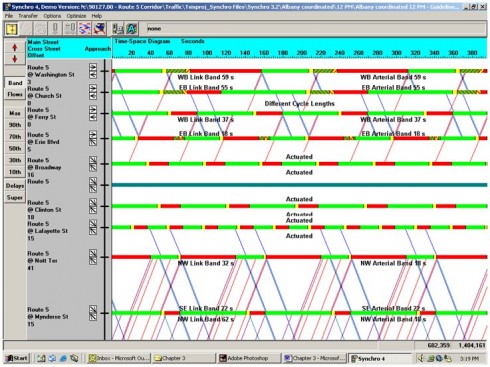In theory, there’s no difference between theory and practice, but it practice, there is.
attributed to:
Yogi Berra
Jan L. A. van de Snepscheut
Albert Einstein
An optimal traffic-signal system would never present anyone with a red light or a don’t walk signal unless there actually is interfering traffic. In theory.
In practice, though, it may be desirable to introduce some delay in order to smooth the flow of traffic — to get vehicles on board a “green wave.” Traffic engineers think in sophisticated ways about this issue, but do not have the real-world tools to resolve it. While synchronized traffic-signal systems and sensor-actuated signals already improve the situation over uncoordinated timed signals, better sensing and more sophisticated software could, at least in theory, achieve much more.
Probably the most difficult part of the problem is in sensing approaching vehicles and pedestrians far enough ahead of an intersection so signals will change as they reach the intersection. Sensors are expensive, and many more would be needed. On the other hand, in a city dotted with security cameras, the sensor data may be easier to obtain, especially if traffic control is a goal when installing the equipment.
I am emphatically not describing so-called intelligent highway systems, intended to automate driving by taking control of vehicles. The driver then supposedly becomes a passenger, free to dial the cell phone, read the newspaper, watch TV or apply makeup without concern. For automated control to work, the system must exert at least as reliable control over vehicles as attentive drivers do. More yet: car makers have huge legal problems resulting from defects that injure only a small number of customers.
Automated control presently is applied only under very restricted conditions, on airport shuttle trains and the like. Even with a great increase in sophistication, it’s hard to conceive of how automated control (other than in collision-avoidance systems) would work on any roads except limited-access highways restricted to vehicles equipped for it.
Even under these conditions, there are difficult technical problems. Collision-avoidance systems to prevent collision with large objects ahead are just beginning to be common. Avoiding debris in the road, potholes and other smaller obstacles requires sophisticated sensing which a driver routinely performs — but well beyond the abilities of automated systems.
So, I am describing not a system to take over control of vehicles, but one to improve control of traffic signals. Humans would retain the ability to prevent collisions, and malfunctioning of the system would lead only to delay, not to crashes. The system would make little difference to anyone — motorist, bicyclist or pedestrian — except to reduce pointless delay.
Will this happen? If so, when and where? One promising thought is that it can happen bit by bit, at one intersection and another, rather than all at once along an entire highway.
[Update, September 2025: as of now, automated vehicles are increasingly able to perform as drivers; connected vehicles, responding to control from outside, are another story entirely. In my opinion, connected vehicles remain a pipe dream due to the limitations of bandwidth and unreliability of communication.]


The other approach is to do away with traffic signals entirely, as done with roundabouts. Roundabouts have been shown to reduce fatal and serious injuries by an astounding 90% over signalized intersections. And research just released by the FHWA indicates the even blind pedestrian do as well crossing single-lane roundabouts as signalized intersections, although addition treatments (such as raised crosswalks, pedestrian hybrid beacons aka “HAWK” or possible RRFBs) are needed for multi-lane roundabouts.